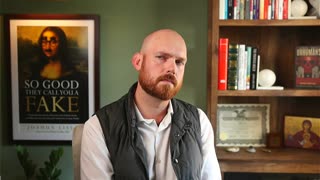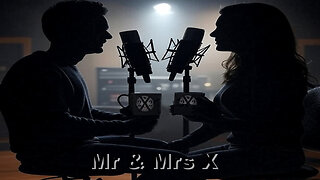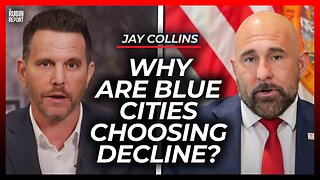Premium Only Content

How to Say NO ft. "I Don't Really Care, Margaret" — Daily Persuasion with Joshua Lisec Ep. 134
Would you like to write a persuasive BOOK? One that changes minds and influencers behavior for years to come? Start with a GOLDEN book idea. Let NEW YORK TIMES bestselling author Joshua Lisec teach you: https://lisecghostwriting.com/golden
ABOUT TODAY'S EPISODE:
Saying “NO” Might Just Be the Most Powerful Thing You Ever Learn to Do. Especially in today’s culture, where “yes” is demanded at every turn, your ability to say no — with clarity, conviction, and confidence — may be the strongest persuasion tool you possess. That’s exactly what this week’s episode of Daily Persuasion with Joshua Lisec dives into. Welcome to Episode 134: “How to Say NO ft. ‘I Don’t Really Care, Margaret’.”
In this masterclass on persuasion psychology, Lisec walks us through one of the most viral political moments of 2025: the JD Vance interview with CBS’s Margaret Brennan. The moment when VP Vance coolly responded, “I don’t really care, Margaret,” became more than just a meme — it became a rallying cry for anyone who’s had enough of emotional blackmail disguised as journalism. In this Margaret Brennan interview, we see a real-time demonstration of the kind of persuasion techniques you can use in your personal and professional life — especially when saying no is the only power move left.
Joshua Lisec analyzes the JD Vance I don’t really care moment through the lens of persuasive techniques and real-world examples of persuasion in advertising. Why did it work? Because it was a complete rejection of a manipulative frame — and that’s something Lisec urges every viewer to learn to do. Whether you're facing a hostile interviewer, a pushy boss, or just societal pressure to comply, this episode shows you how to say no with backbone and strategy.
“No” isn't just a refusal — it's a reset. A boundary. A redefinition of the conversation. Lisec explains that mastering this word is central to every effective persuasion technique. He outlines how to persuade someone to do something by first refusing to accept their assumptions. That’s right — to persuade others, you must first stand firm in your own convictions. The JD Vance Margaret Brennan exchange is a prime case study in this.
Lisec also explains the psychology behind persuasion — how the left tends to frame arguments in emotionally charged ways that assume you already agree. By refusing to even entertain those assumptions, as VP Vance did, you shatter the entire premise of the emotional appeal. This is persuasion by negation, and it's a tactic that Lisec suggests is vital for anyone trying to protect their values — or their personal brand.
Yes, your personal brand matters here too. Saying “no” effectively is not just about political sparring — it’s about not allowing others to define you, especially in high-stakes conversations. Lisec drives home that every time you set a firm boundary, you're reinforcing your brand’s values. Every “no” is a statement of identity.
Throughout this episode, Lisec offers persuasion examples from recent headlines and timeless psychology, demonstrating how techniques of persuasion in writing, media, and public relations hinge on controlling the frame. And as you’ll learn, you don’t always have to be agreeable to be persuasive. Sometimes, “I don’t really care, Margaret” is all the persuasion you need.
This episode is a must-watch for anyone interested in daily persuasion, persuasion psychology, and the practical application of persuasive techniques in everyday life. If you've ever wondered how to persuade someone to do something without giving up your values or playing emotional games, this is your blueprint. Whether you’re in business, politics, media, or just trying to navigate an increasingly manipulative world, knowing how to say no is non-negotiable.
Don’t miss Daily Persuasion with Joshua Lisec Episode 134: “How to Say NO ft. ‘I Don’t Really Care, Margaret’.” This isn’t just about politics. It’s about power. Your power. And knowing when to use it. Just like VP Vance did in that unforgettable JD Vance interview.
Because sometimes the most persuasive thing you can say is… nothing more than “no.”
Watch now. Learn the persuasion toll. Master the art of refusal. And remember — most Americans probably agree with you.
-
 8:33
8:33
Daily Persuasion with Joshua Lisec
10 days agoThe Secret to Great Ghostwriting — Daily Persuasion with Joshua Lisec Ep. 312
351 -
 9:56
9:56
It’s the Final Round
13 hours ago💰NFL Week 4 Best Bets🔥Player Prop Picks, Parlays, Predictions FREE Today September 28th
2.07K -
 LIVE
LIVE
TheItalianCEO
2 hours agoFortnite WINS all day w/GlamourX
98 watching -
 25:11
25:11
Stephen Gardner
18 hours ago🚨Trump has been trying to WARN US!!
91.5K139 -
 51:41
51:41
X22 Report
5 hours agoMr & Mrs X - Tylenol Is The Start, All Roads Lead To The Vaccines, Chatter Amongst Big Pharma - Ep 9
109K35 -
 LIVE
LIVE
ttvglamourx
2 hours ago $0.04 earnedGLAMS DELULU FOR FORTNITE !DISCORD
95 watching -
 35:24
35:24
The Rubin Report
22 hours agoThe Simple Rules to Fight Crime Blue Cities Choose to Ignore | Jay Collins
46.5K26 -
 LIVE
LIVE
BBQPenguin_
7 hours agoRivals Road to ELITE!
24 watching -
 LIVE
LIVE
RJTWIN
1 hour ago🔴LIVE - First Time Playing! | Halo 3 | Clean Content - !blerp !discord !rumbot
19 watching -
 6:35:10
6:35:10
FyrBorne
13 hours ago🔴Warzone M&K Sniping: Modern Warfare Weapons That Still Cook in 2025
261K3